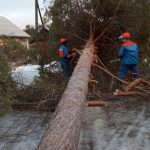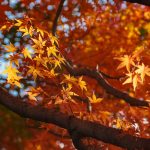Should Leaves be Raked?
Fall is a beautiful season of changing colors and cooler temperatures, but with all the beauty comes an inevitable mess. One of the most common complaints about Fall is the number of leaves that pile up on lawns and gardens. This leads to the inevitable question (mostly from teenagers tasked with the job): should leaves be raked?
Should Leaves be Raked? Maybe Not
Any homeowner with big beautiful maple trees knows a big sheet of leaves on your lawn can leave some unattractive bald spots on the lawn. Those bare patches can be a bit of a chore to fill in and may not be fully healed for a season. But can those leaves actually be helping your lawn, too?
Fallen leaves actually make great natural fertilizer for your yard and the environment at large. They are packed full of organic matter like nitrogen, phosphorus, and potassium that can help nourish both your soil and grass. Of course, this doesn’t mean you should simply let them pile up–it’s important to spread them out evenly so it’s more efficient for the lawn and flowerbeds.
The best way to make sure each plant gets its fair share of nutrients is by composting the leaves. Composting helps break down the leaves more quickly than they would decompose naturally in your soil. Composting also provides additional benefits like adding microbial activity to your garden beds and an eco-friendly way of getting rid of certain food scraps and other decomposables.
But you still have to rake them up, right? If you don’t have a compost bin or don’t want to take on the task of managing one, simply spread the leaves evenly across your flower beds and lawn using a rake or leaf blower. Make sure not to cover any flowers or vegetables that are still growing as this could prevent them from getting enough sunlight.
Depending on how many leaves you have, you can even do a little power mulching with your lawnmower. You can make a few passes to vacuum up the leaves or take the bag off and let the chopped-up bits fly around the yard. You’ll still want to even out thick clumps, but it will help the leaves decompose while still letting the lawn breathe.
When Leaves SHOULD Be Raked
If you live in an area where there are large amounts of fallen leaves every year, then it might be wise to rake those suckers up or invest in a powerful leaf blower to blow leaves into piles around the yard. Trying to mow a thick leaf layer of leaves may only succeed in grinding the leaves into the soil that much more and could smother the grass.
Just remember not to leave too many piles around for too long after raking. For one, a brief windstorm could come through and undo all of your hard work! Leaving piles for more than a few days can also attract pests such as rodents and other small animals looking for a cozy place for winter hibernation.
Just leaving all those leaves where they are can also be costly. Aside from the looks of it (if you’re worried about that kind of thing), the thick layer of fallen leaves can deprive the grass of sunlight, water, and air, making it difficult for the grass to grow. These leaves can also be blown into the street, clogging storm drains, and leading to flooding in the area.
Should Leaves Be Raked? Only You Know For Sure
Whether you’re dealing with piles upon piles of fallen leaves or just a few scattered here and there, it’s important to know how best to manage them so they don’t ruin your yard. Leaves do have natural benefits, such as providing essential nutrients and keeping weeds away with mulch layers.
Not to mention the local ecosystem. David Mizejewski, a naturalist at the National Wildlife Federation, told USA TODAY the layer of leaves is an important wildlife habitat that can form an entire ecosystem. From worms that help the soil to smaller insects that feed birds. Luckily, in the Pacific Northwest, there are plenty of places where leaves are left alone to help in this arena.
But don’t ignore possible issues, either: to keep all these risks at bay, make sure you take some time out of your day to rake up those fallen leaves. With just a little bit of effort now, you can ensure that when winter transitions into warmer days again. Instead of patching up bald spots, you can get out and enjoy those first days of Spring.




